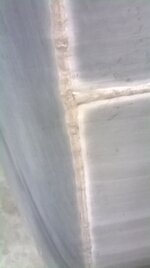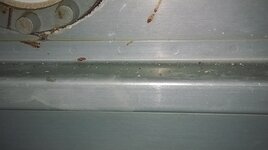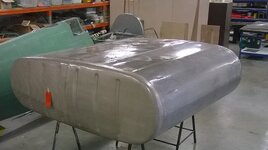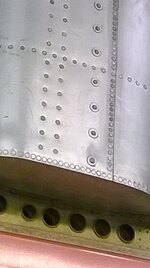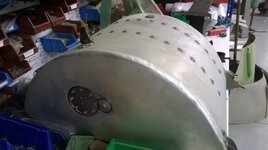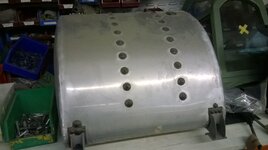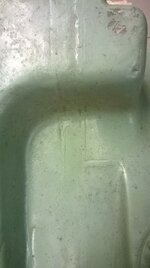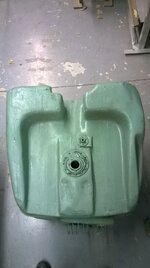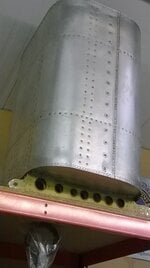Navigation
Install the app
How to install the app on iOS
Follow along with the video below to see how to install our site as a web app on your home screen.
Note: This feature may not be available in some browsers.
More options
You are using an out of date browser. It may not display this or other websites correctly.
You should upgrade or use an alternative browser.
You should upgrade or use an alternative browser.
Metal fuel tank materials?
- Thread starter chris ballance
- Start date
Ad: This forum contains affiliate links to products on Amazon and eBay. More information in Terms and rules
More options
Who Replied?MiTasol
Captain
MIflyer
Captain
I watched a friend change out the fuel tank liners in a Bonanza. Could not believe it. It looked to me like trying to stuff a car cover in your mouth.
RichardSuhkoi
Airman 1st Class
- 183
- Apr 27, 2021
Russian IL-2 ran tiny tubes from exhaust to tank. Just enough inerting to prevent most ignition.I think some used exhaust gases as a purge, not strictly speaking "inert". A big disadvantage to anything carbon steel is that they rust.
RichardSuhkoi
Airman 1st Class
- 183
- Apr 27, 2021
I had some old rubber tank liners once and sold them as flotation devices. I watched my Father install some using talcum powder to help creases settle.I watched a friend change out the fuel tank liners in a Bonanza. Could not believe it. It looked to me like trying to stuff a car cover in your mouth.
Spitfire Steve
Airman
These are fuel tanks from Gloster Gladiator 1-3 Riveted together. Avro Lancaster 4-6 Gas welded seams but structure on the inside is is spot welded to outer skin.Were the shells of most ww2 era internal fuel tanks made of carbon steel?
Attachments
Spitfire Steve
Airman
SThese are fuel tanks from Gloster Gladiator 1-3 Riveted together. Avro Lancaster 4-6 Gas welded seams but structure on the inside is is spot welded to outer skin.
Sorry, 1-2 are Spitfire Mk8 then Gladiator and Lanc. Spitfire none Photo recon were riveted but PR Spits were were welded due to the pressure at altitudeThese are fuel tanks from Gloster Gladiator 1-3 Riveted together. Avro Lancaster 4-6 Gas welded seams but structure on the inside is is spot welded to outer skin.
MiTasol
Captain
Thank you Steve.
Good clean clear photos.
Many British and US tanks had the rivets welded as well as the seams so this leads to the question - were all these tanks designed to be used bare or covered? I know Spitfire was covered and notice they have used PRC1422 or a similar sealant on the 016.jpg tank.
If bare how were the rivets sealed originally?
I do not have photos but the Beaufort tanks were fully welded - the minor baffles were welded to the main baffle bulkheads and then the skins welded to the T sections on the top of the bulkhead baffles.
Good clean clear photos.
Many British and US tanks had the rivets welded as well as the seams so this leads to the question - were all these tanks designed to be used bare or covered? I know Spitfire was covered and notice they have used PRC1422 or a similar sealant on the 016.jpg tank.
If bare how were the rivets sealed originally?
I do not have photos but the Beaufort tanks were fully welded - the minor baffles were welded to the main baffle bulkheads and then the skins welded to the T sections on the top of the bulkhead baffles.
MIflyer
Captain
The original tanks on my Ercoupe, made in 1946, used "ternplate" which is steel covered by tin. They are rivited together and then the seams are sealed with lead/tin solder. Most of those tanks were later replaced by stainless steel or aluminum tanks but the header tank on my airplane is still the ternplate. For the later tanks they had a sealant sloshed inside.
Spitfire Steve
Airman
Tanks were usually covered with self healing rubber that if it got a bullet or shrapnel damage the fuel reacted with the rubber and self sealed. The rubber was heat stuck to the tank and covered with linen fabric, usually painted green and stenciled with various markings. The Lanc tanks in the photo were covered but it has been removed for inspection. Never to be fitted again, as you can't detect any leaks or corrosion when it's wrapped. You are right PRC 1422 on the Gladiator top tank. The other was made by someone else and I think this has had some sort of soldering done, but I haven't had a close look at it yet.Thank you Steve.
Good clean clear photos.
Many British and US tanks had the rivets welded as well as the seams so this leads to the question - were all these tanks designed to be used bare or covered? I know Spitfire was covered and notice they have used PRC1422 or a similar sealant on the 016.jpg tank.
If bare how were the rivets sealed originally?
I do not have photos but the Beaufort tanks were fully welded - the minor baffles were welded to the main baffle bulkheads and then the skins welded to the T sections on the top of the bulkhead baffles.
Thank you Steve.
Good clean clear photos.
Many British and US tanks had the rivets welded as well as the seams so this leads to the question - were all these tanks designed to be used bare or covered? I know Spitfire was covered and notice they have used PRC1422 or a similar sealant on the 016.jpg tank.
If bare how were the rivets sealed originally?
I do not have photos but the Beaufort tanks were fully welded - the minor baffles were welded to the main baffle bulkheads and then the skins welded to the T sections on the top of the bulkhead baffles.
Attachments
- Thread starter
- #51
chris ballance
Airman 1st Class
- 151
- Jul 21, 2022
Thanks guys for these great photos with their amazing details. They make me more curious about aluminum welding during the period. I'm sure the lead/tin soldering of fuel tanks was fun.
Last edited:
Wildcat_drvr
Airman
On the B-17, for example, the fuel tanks in the wing as well as the oil tanks were bladders made of rubber and were self-sealing. The same was for the B-29, F4U, P-51 and many more US aircraft. The auxiliary fuel tanks carried in the bomb bay of the B-17 and B-29 were aluminum. Wet wings were very rare as the sealing methods and materials available at the time were not adequate for the job. In addition, flexible structures made wet-wings even harder to seal. Case in point is the Vultee BT-13 which has a wet wing and is just about impossible to keep from leaking.
Wildcat_drvr
Airman
Many of those bladders were made by Ball Band in Mishawaka Indiana, They also made Red Ball Jets! Ball Band eventually became Uni Royal, naugahyde!!
MiTasol
Captain
Varies according to the manufacturer but 3/8 to 3/4 inch (10-20mm) in ww2 was not uncommon.
Here is part of a blueprint from one typical tank - those are 1/4 inch bolts.

Here is part of a blueprint from one typical tank - those are 1/4 inch bolts.
MiTasol
Captain
But a lot thicker than the 0.040 (1mm) of a metal tank so a significant loss of volume in a small tank and a lot of aircraft like the P-39 had a lot of small tanks.

GrauGeist
Generalfeldmarschall zur Luftschiff Abteilung
To give an idea of volumn loss, take a sheetmetal box (of any size) and line it (sides, bottom, etc.) with 3/8" (10mm) plywood.
10mm is a minimum, the sealing material could be as thick as 1/2" (13mm) depending on the time, material and nation.
You'll find that the internal volumn of your box decreases quickly. You'll also find that the empty weight of your box has suddenly increased in weight considerably, too.
10mm is a minimum, the sealing material could be as thick as 1/2" (13mm) depending on the time, material and nation.
You'll find that the internal volumn of your box decreases quickly. You'll also find that the empty weight of your box has suddenly increased in weight considerably, too.
MIflyer
Captain
I watched a friend of mine putting a new bladder in a Bonanza wing.
I looked at the size of the bladder and the size of the holes and said, "You have GOT to be kidding me!" It looked like you were trying to stuff a football into a test tube. But it went in.
I looked at the size of the bladder and the size of the holes and said, "You have GOT to be kidding me!" It looked like you were trying to stuff a football into a test tube. But it went in.
Shortround6
Lieutenant General
That was part of the problem with the P-39 wing. The P-39 wing had been designed for integral tanks. The protected "tanks" weren't really tanks but self sealing bladders that "fit" in the spaces. Which did not fit in the corners/angles well. The bladder also had to supply the strength unlike as Bladder or coating that was applied to an existing fuel tank which carried the weight/load and only had to provide the sealing part of the solution.I watched a friend of mine putting a new bladder in a Bonanza wing.
I looked at the size of the bladder and the size of the holes and said, "You have GOT to be kidding me!" It looked like you were trying to stuff a football into a test tube. But it went in.
Users who are viewing this thread
Total: 1 (members: 0, guests: 1)
Similar threads
- Replies
- 0
- Views
- 719

